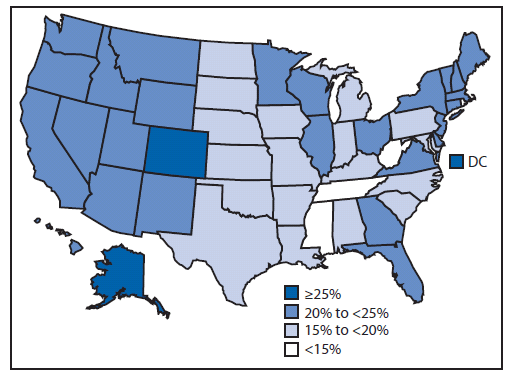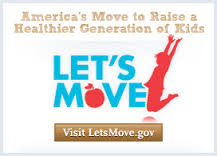
Only 1 in 5 Americans got the minimum recommended amount of physical activity in 2011, based on guidelines offered by the U.S. Centers for Disease Control.
More men than women met the standard: 23.4% of men versus 17.9% of women. There are wide variations across the 50 states, as the map shows, with the healthiest folks exercise-wise living in the west, Alaska, upper midwest, and New England. The range runs from a 12.7% low in West Virginia and Tennessee to 27.3 at the high end in Colorado.
That bar is set at 150 minutes a week (that’s 2.5 hours) of moderate-intensity aerobic activity, or 75 minutes of vigorous-intensity aerobic activity a week, as well as participating in muscle-strengthening at least twice a week.
The CDC analyzed 2011 data from the BRFSS survey conducted among nearly one-half millions adults over 18, conducted via landline and cellular telephone.
College graduates had higher prevalence of both the aerobic and muscle-strengthening activity (27.4%) nationwide, decreasing with education levels. Higher BMI correlated to lower levels of physical activity.
Health Populi’s Hot Points: The physical activity shortage found by the CDC is a clear wake-up call that sedentary behavior is the norm in America, not the exception. Even in the most active states of Colorado and Alaska, three in four people aren’t getting up offa their things at the minimum recommended standard.
These low achievement levels suggest that even moving the needle from one cohort to the next would improve public health: say, getting Texans and Michiganders to go from the 15-20% band to the 20-25% tier, and Floridians and Oregonians to migrate from 20-25% up to the over 25% group.
 We’re not looking for all people to emulate Jack Lalanne and Jillian Michaels here. The First Lady is working hard to get people moving through the Let’s Move campaign. This is a start, but needs pushing and social networking.
We’re not looking for all people to emulate Jack Lalanne and Jillian Michaels here. The First Lady is working hard to get people moving through the Let’s Move campaign. This is a start, but needs pushing and social networking.
You can start by adopting walking meetings at work, or inviting a neighbor to walk with you in the morning. You can take the stairs at work at encourage your colleagues to do the same. Wear a self-tracking device: these can help you become more self-aware of moving and taking those extra steps required to meet a daily goal.
Health is social, and walking certainly is. Let’s Move, together. If we do so, we’ll move the needle on BMI, diabesity, and public health.




 Thank you, Trey Rawles of @Optum, for including me on
Thank you, Trey Rawles of @Optum, for including me on  I was invited to be a Judge for the upcoming
I was invited to be a Judge for the upcoming  For the past 15 years,
For the past 15 years,